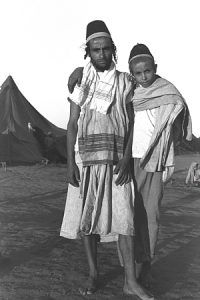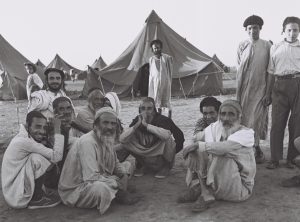Were you to tie tzitzit on a super small beged, obviously everyone would agree you can’t carry out the mitzvah of tzitzit with a tallis katan that small. What, then, is the size requirement for a tallis katan? The answer is a bit complicated.
In Masechet Menachot and the Shulchan Aruch (O.C. 16, 1) we find that a tallit katan has to be large enough to cover the head and most of the upper body of a boy old enough to walk around town on his own.
שעור טלית שחיב בציצית שיתכסה בה בארך וברחב ראשו ורבו של קטן המתהלך לבדו בשוק ואינו צריך אחר לשמרו

 According to the leading halachic authorities, this refers to a boy around the age of 9. If the garment is large enough for a 9-year-old, then it’s large enough. Other poskim debate whether it also has to be big enough so that an adult would not feel embarrassed wearing it in public.
According to the leading halachic authorities, this refers to a boy around the age of 9. If the garment is large enough for a 9-year-old, then it’s large enough. Other poskim debate whether it also has to be big enough so that an adult would not feel embarrassed wearing it in public.
Since clothing styles have changed since then, it’s not easy to translate this into practical size guidelines. According to some opinions, the total length of the beged (front and back) must be 1.5 amah, while others say it must be 2 amos. The prevailing opinion is that the width must be one amah.
I’ve always tried to imagine what it looks like to wear a garment that way. My sense is that during the time of the Gemara, people often wore garments as a wrap, unlike the tallit katan we know today with a big hole in the middle.
While reading about the current investigations in Israel regarding the disappearing children in the 1950s, I came across these photos of Yemenite Jews in transit camps in the early 1950s. In the photo on the left, I’m wondering whether that’s the way the boy typically dressed, or whether he just tossed a blanket over his shoulders in the early morning hours or when it started getting chilly? If that’s how he dresses, how come I can’t see tzitzit? Perhaps the corners are a bit rounded?
(BTW, one of the reasons why the topic of the Yemenite Children Affair — Parshat Yaldei Teiman — is of great interest to me is because my wife’s aunt a”h, who came from Kurdistan to Eretz Yisrael during that period, had ten children, but when one of them was a few days old and perfectly healthy, a nurse at the hospital told her that the baby had died, yet there was no death certificate, no burial and no explanation proffered.)

